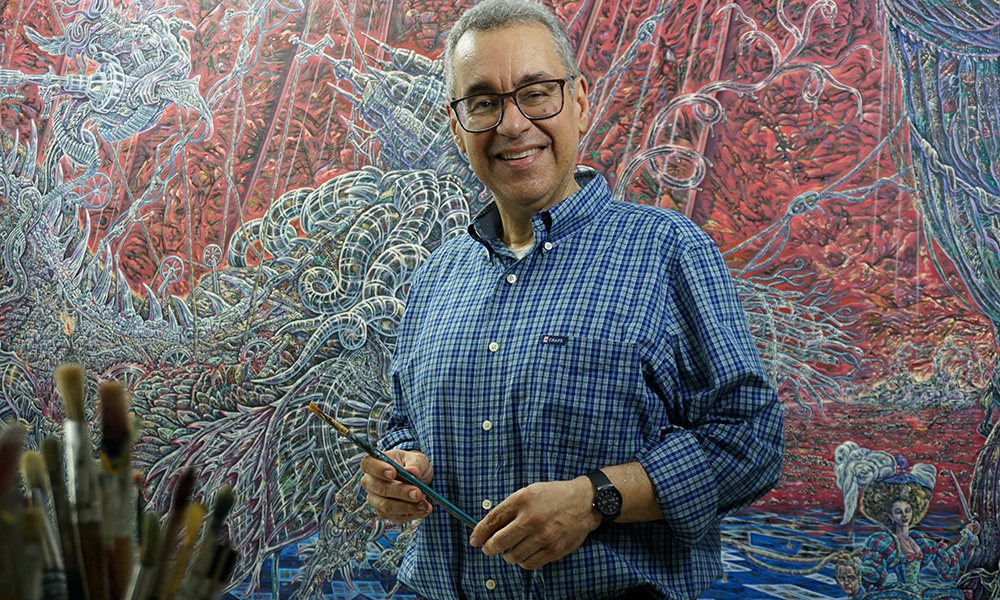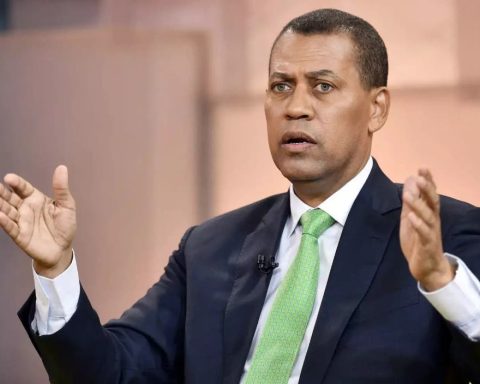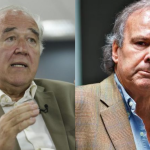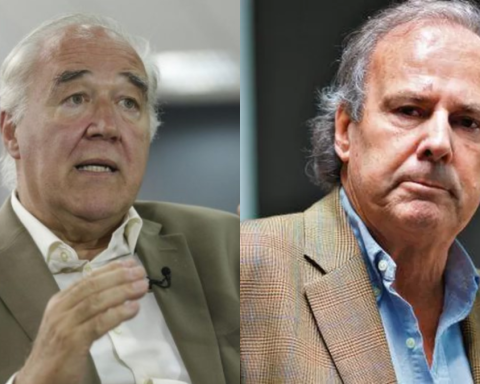Vladimir Velázquez is an artist whose style leaves no one indifferent. His works mix nightmarish figures with such finely crafted and delicate strokes that they are astonishing due to the level of perfection and even the transparency he achieves in each canvas. He confesses that he would like to make a living from art, but in this country that is so difficult that he has to work as a bank employee. But since one cannot make a living from artistic activity, he dedicates most of his free time to painting, but he has also recently published a book of short stories entitled Dominican Splendors, a collection of stories that alternate hallucinatory and terrifying stories, with masterful illustrations of his own.
How did you get started in drawing and painting?
Since I was little I started to draw and trace lines everywhere, so my mother soon realized that my interests were in that direction and she sent me to study drawing at a school in Caracas. I spent my early childhood in Venezuela. My parents were exiled for political reasons, but when there was an amnesty we returned to the country. I studied at the Leonardo Da Vinci Art School, which was directed by Professor Elías Delgado. Then I studied at Cándido Bidó’s school. Then I studied Visual Arts and then Architecture at the UASD. I took a summer course in Chavón and then at Alberto Bass’s school. He taught me many techniques.
When was your first exhibition?
That was in 1985. I belonged to a collective called Generation of 80, it was a group of very young artists, I participated in several collective exhibitions, next year I will celebrate forty years in the art world…
Who are the artists that have most influenced your current style?
I won’t talk about the Dominicans because there are many and I wouldn’t like to leave anyone out, my teacher Alberto Bass, Domingo Liz, who has already passed away, and from further away… I always liked El Bosco (Hyeronimus Bosch), he always fascinated me for his mystery, his richness, another is Alberto Durero, an absolute genius, another is Matías Grünewald, German, and the closest ones, the surrealists, Max Ernst, Dorothea Tanning, Eleonora Carrington, and there are many more, like Remedios Varo and Ernst Fuchs, a Swiss who died recently.
What is the purpose of the art you make? What do you want to convey?
Images appear in my mind as representations. I see them in my imagination and they don’t leave me alone. It’s like I’m constantly being hammered until I can sit down at my work table. First I make lots of sketches until I get to what I wanted to achieve. Colour comes later. That’s another characteristic of mine. Painting relaxes me. I listen to music when I paint and then I let the work take me along its own paths. As an artist in a time of conflict like the one we live in, I want to express the struggle of human beings to survive, to not let themselves be crushed by the powerful, to not submit to the domination of this great leviathan that is modern society.
How do you see, in the panorama of painting, the relationship between Dominican artists?
I have a lot of respect and I have many friends, I know very talented people, even among the younger artists, and I try to stay away from many things. It is common in the art world to have bitter confrontations between people who do not share ideas. Undoubtedly, and I am categorical in this, I obviously do not agree with the modern tendencies of turning garbage into art, there are places where I am no longer invited, places that cultivate the VIP art that the Mexican critic Avelina Lesper talks about. When things are easy, there is no art there, when rubble and stones are put and exhibited in a museum and even win prizes, that is an aberration, because it is also a bad example for young artists who are just beginning their journey.
What is your opinion about the national fairs and competitions held in our country?
Here, as everywhere, these salons are set up by groups or clans that seek each other out, help each other, form a structure, and among them there are people who make VIP art. This does a disservice to society when the same group always benefits from these salons and competitions… one of these salons is the National Biennial, I no longer participate, I’m tired of it, I’ve participated many times and even won once, but lately I see that the goal is always to reward people who make the same kind of art, it is formed as an elite and although there are talented people, the best are not always rewarded.
How would you define art from your own point of view?
It is a very difficult concept to define, like philosophy, for example, but art is an activity, a discipline that serves to bring to the surface the best that each one has to give, one of the functions of art is to make us better people, in the case of countries that have a long tradition and that prioritize artistic education, they have a much deeper identification with their own roots, they know better and preserve their own culture.
What advice would you give to young people who are just starting out in the arts in general?
I don’t like giving advice, I don’t consider myself with enough authority to do so, but I can suggest that, above all, you listen to your instincts, that you don’t get carried away by trends, that you follow your deepest passions, only in this way can you find your own voice, your own style, because the worst thing that can happen is to become a frustrated person, as happens even to those who abandon an artistic activity to dedicate themselves to making money, I know many cases of people who have made a fortune and yet are not happy at all.

















